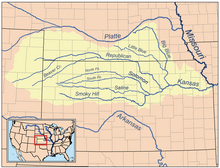| Big Blue River | |
|---|---|
 | |
 Map of the Kansas River drainage basin showing the Big Blue and Little Blue rivers | |
| Native name | Great Blue Earth River (Kansa) |
| Location | |
| Country | United States |
| State | Nebraska, Kansas |
| Region | Great Plains |
| Cities | Manhattan, KS, Beatrice, NE, Crete, NE, Seward, NE |
| Physical characteristics | |
| Source | |
| • location | Near Aurora, NE, Great Plains, United States |
| • coordinates | 40°57′00″N 098°04′31″W / 40.95000°N 98.07528°W[1] |
| Mouth | Kansas River |
• location | Near Manhattan, Great Plains, United States |
• coordinates | 39°11′17″N 096°31′40″W / 39.18806°N 96.52778°W[1] |
| Length | 359 mi (578 km), South[2] |
| Basin size | 9,696 sq mi (25,110 km2)[3] |
| Discharge | |
| • location | Manhattan, KS[4] |
| • average | 982 cu ft/s (27.8 m3/s)[4] |
| • minimum | 8 cu ft/s (0.23 m3/s) |
| • maximum | 18,000 cu ft/s (510 m3/s) |
| Basin features | |
| River system | Kansas River watershed |
| Tributaries | |
| • left | Little Blue River, West Fork of the Little Blue River |
The Big Blue River is the largest tributary of the Kansas River. The river flows for approximately 359 miles (578 km)[2] from central Nebraska into Kansas, until its confluence with the Kansas River at Manhattan.
It was given its name by the Kansa tribe of Native Americans, who lived at its mouth from 1780 to 1830, and who called it the Great Blue Earth River.
- ^ a b "Big Blue River". Geographic Names Information System. United States Geological Survey, United States Department of the Interior. 1978-10-13. Retrieved 2013-08-17.
- ^ a b U.S. Geological Survey. National Hydrography Dataset high-resolution flowline data. The National Map Archived 2012-03-29 at the Wayback Machine, accessed March 30, 2011
- ^ "Kansas-Nebraska Big Blue River Compact" (PDF). 1971. Archived from the original (PDF) on 2009-03-26.
- ^ a b "USGS Current Conditions for USGS 06887000 BIG BLUE R NR MANHATTAN, KS".